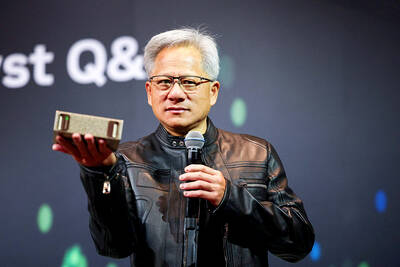The Walkman, the iconic Japanese electronic gadget, will no longer be made in Japan, Sony Corp announced yesterday, shifting the last production of the portable jukebox to China and Malaysia.
Sony will close its MD and CD player Walkman production lines at its Saitama Tech factory north of Tokyo by March next year, company spokeswoman Saori Takahashi said.
The factory produced Sony's first Walkman tape cassette players in 1979, which revolutionized the way the world listened to music at the start of the music-video era.
Sony, which has been struggling in the face of Apple Computer Inc's phenomenally popular iPod, will cut 200 jobs at the plant.
"The decision was based on our company's idea that we will concentrate on production in the best possible places in the world," Takahashi said.
Sony, like other Japanese companies, has increasingly relied on other Asian nations, particularly China, as hubs for low-cost manufacturing.
"The Walkman has long been a symbolic and strategic product for Sony, but it has now turned into just one item that should be produced overseas due to labor costs," said Masayuki Hoshina, an analyst at Okasan Research Institute.
"Japanese manufacturers will further differentiate high-value added products and low-value added ones," Hoshina said. "The former remain at home and the latter will be sent overseas. Such a trend will continue in the future, too."
Sony separately said it would also end production of cathode-ray tube displays in the US this year.
It will close its San Diego plant in June and lay off 400 employees there while ending production at its factory in Pittsburgh in February with 300 job losses.
It will focus on its production of cathode-ray tube displays in Singapore and China, Takahashi said.
In September last year, Howard Stringer, a Welsh-born former television journalist who is Sony's first foreign boss, announced a major overhaul of the business including 10,000 job cuts as the company struggles to cope with intense competition in key markets.
Sony has increasingly tried to repackage the Walkman, last year for example trying to target a younger crowd with a Walkman that looks like a jelly bean.
Sony has forecast shipments of the Walkman series at 13.85 million units for the year to March, up from 11.94 million the previous fiscal year.
Sony posted a net profit of ¥28.5 billion (US$247 million) for the three months to September, down 46.5 percent from a year earlier as restructuring charges of ¥32.9 billion contributed to the slide.

SEEKING CLARITY: Washington should not adopt measures that create uncertainties for ‘existing semiconductor investments,’ TSMC said referring to its US$165 billion in the US Taiwan Semiconductor Manufacturing Co (TSMC, 台積電) told the US that any future tariffs on Taiwanese semiconductors could reduce demand for chips and derail its pledge to increase its investment in Arizona. “New import restrictions could jeopardize current US leadership in the competitive technology industry and create uncertainties for many committed semiconductor capital projects in the US, including TSMC Arizona’s significant investment plan in Phoenix,” the chipmaker wrote in a letter to the US Department of Commerce. TSMC issued the warning in response to a solicitation for comments by the department on a possible tariff on semiconductor imports by US President Donald Trump’s

‘FAILED EXPORT CONTROLS’: Jensen Huang said that Washington should maximize the speed of AI diffusion, because not doing so would give competitors an advantage Nvidia Corp cofounder and chief executive officer Jensen Huang (黃仁勳) yesterday criticized the US government’s restrictions on exports of artificial intelligence (AI) chips to China, saying that the policy was a failure and would only spur China to accelerate AI development. The export controls gave China the spirit, motivation and government support to accelerate AI development, Huang told reporters at the Computex trade show in Taipei. The competition in China is already intense, given its strong software capabilities, extensive technology ecosystems and work efficiency, he said. “All in all, the export controls were a failure. The facts would suggest it,” he said. “The US

The government has launched a three-pronged strategy to attract local and international talent, aiming to position Taiwan as a new global hub following Nvidia Corp’s announcement that it has chosen Taipei as the site of its Taiwan headquarters. Nvidia cofounder and CEO Jensen Huang (黃仁勳) on Monday last week announced during his keynote speech at the Computex trade show in Taipei that the Nvidia Constellation, the company’s planned Taiwan headquarters, would be located in the Beitou-Shilin Technology Park (北投士林科技園區) in Taipei. Huang’s decision to establish a base in Taiwan is “primarily due to Taiwan’s talent pool and its strength in the semiconductor

French President Emmanuel Macron has expressed gratitude to Hon Hai Precision Industry Co (鴻海精密) for its plan to invest approximately 250 million euros (US$278 million) in a joint venture in France focused on the semiconductor and space industries. On his official X account on Tuesday, Macron thanked Hon Hai, also known globally as Foxconn Technology Group (富士康科技集團), for its investment projects announced at Choose France, a flagship economic summit held on Monday to attract foreign investment. In the post, Macron included a GIF displaying the national flag of the Republic of China (Taiwan), as he did for other foreign investors, including China-based